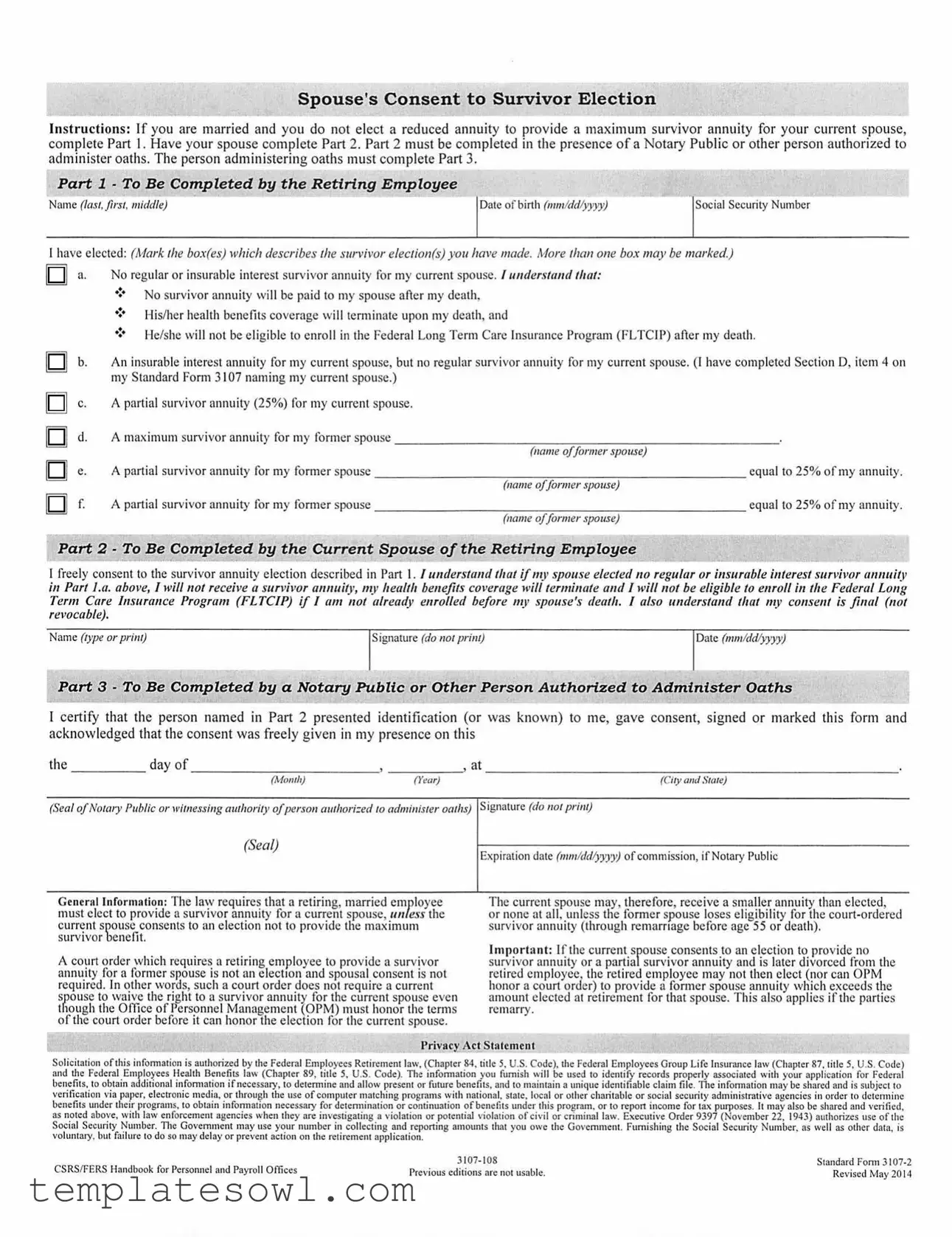What is the SF 3107-2 form?
The SF 3107-2 form is a document used by retiring federal employees who are married. This form is necessary for the election of a survivor annuity for a current spouse. It requires consent from the spouse if the employee decides not to provide a maximum survivor annuity. The completion of this form involves multiple sections that must be filled out by both the retiring employee and the current spouse, including notarization.
When should I complete the SF 3107-2 form?
You should complete the SF 3107-2 form during the retirement process, typically as part of your retirement application package. This should be done as soon as you decide whether to elect a regular survivor annuity for your spouse or not. The timely completion of this form is crucial to ensure all parties understand their rights and benefits before the retirement becomes effective.
What happens if I do not elect a survivor annuity for my spouse?
If you do not elect a survivor annuity, your spouse must complete Part 2 of the form to consent to this decision. Without their consent, the law mandates that a survivor annuity must be provided to the current spouse. If the spouse does not consent, they will not receive any benefits after your death, and their health benefits will terminate.
Can I change my mind after completing the form?
The consent given by your spouse on the SF 3107-2 form is final and cannot be revoked. It is essential to discuss this matter thoroughly with your spouse before submitting the form. Once the form is completed, any decision made regarding the survivor annuity is binding.
What is the role of a Notary Public in the SF 3107-2 form?
A Notary Public or an authorized individual is required to witness the completion of Part 2 of the form. This person certifies that they have verified the identity of the spouse and confirmed that the consent was given freely. This notarization process adds an extra layer of authenticity and legal agreement to the consent provided.
What are the consequences of consenting to a smaller or no survivor annuity?
If your current spouse consents to a smaller or no survivor annuity, they may lose eligibility for certain benefits after your death. For example, their health benefits coverage will terminate, and they will not be eligible for enrollment in the Federal Long Term Care Insurance Program unless already enrolled. Consider these potential losses carefully before agreeing to a reduced annuity.
What is the significance of the Privacy Act Statement on the form?
The Privacy Act Statement on the SF 3107-2 form outlines how the personal information provided will be used and protected. It ensures that the information is collected to determine eligibility and benefits for federal programs. It also specifies that this information may be shared with other agencies for verification or law enforcement purposes if necessary.
Does a court order affect my decisions with the SF 3107-2 form?
Yes, a court order that requires you to provide a survivor annuity for a former spouse does influence your decisions. Even if a court mandates the provision of benefits to a former spouse, you are still required to provide a benefit to your current spouse unless they consent otherwise. The current spouse’s rights cannot be waived simply due to a prior order regarding a former spouse.
What information is required for Part 1 of the form?
In Part 1 of the SF 3107-2 form, you need to provide your name, date of birth, and Social Security number. You must also mark the appropriate boxes indicating your election regarding the survivor annuity options. This part requires careful consideration, as multiple selections can be made, but each choice carries different implications for your spouse's benefits.
Is the SF 3107-2 form applicable to all federal employees?
The SF 3107-2 form specifically applies to federal employees under the Civil Service Retirement System (CSRS) or the Federal Employees Retirement System (FERS). It is essential for married employees in these systems who are making decisions about survivor benefits. If you are unsure of your eligibility, it is advisable to consult your agency's human resources department.

